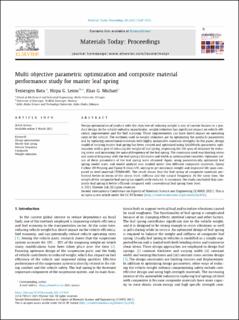| dc.contributor.author | Batu, Temesgen | |
| dc.contributor.author | Lemu, Hirpa Gelgele | |
| dc.contributor.author | G. Michael, Elias | |
| dc.date.accessioned | 2021-08-13T08:46:44Z | |
| dc.date.available | 2021-08-13T08:46:44Z | |
| dc.date.created | 2021-04-21T13:04:48Z | |
| dc.date.issued | 2021-03 | |
| dc.identifier.citation | Batu, T., Lemu, H.G., Michael, E.G. (2021) Multi objective parametric optimization and composite material performance study for master leaf spring. Materials Today: Proceedings, 45. | en_US |
| dc.identifier.issn | 2214-7853 | |
| dc.identifier.uri | https://hdl.handle.net/11250/2767721 | |
| dc.description.abstract | Design optimization of product with the objective of reducing weight is one of current focuses in a product design. In the vehicle industry, in particular, weight reduction has significant impact on vehicle efficiency improvement and the fuel economy. These improvements can have direct impact on operating costs of the vehicle. The methods used to weight reduction are by optimizing the product´s parameters and by replacing conventional materials with highly sustainable materials strengths. In this paper, design model of existing master leaf spring has been created and optimized using SolidWorks parametric optimization with a goal of reducing the weight of leaf spring, improving the life span of structure by reducing stress and increasing the natural frequency of the leaf spring. The constraint used was limiting stress and natural frequency with the leaf spring’s thickness and width as optimization variables. Optimum values of these parameters of the leaf spring were obtained. Again, using parametrically optimized leaf spring model static and modal analysis was studied under two different composite materials, Epoxy Carbon UD Prepreg and Epoxy E-Glass UD, aiming to get minimum weight and improved life span compared to steel material (55SiMn90). The result shows that the leaf spring of composite materials performed better in terms of the stress level, stiffness and the natural frequency. At the same time, the weight of the composite leaf spring has significantly reduced. In summary, the study concluded that composite leaf spring is better efficient compared with conventional leaf spring from steel. | en_US |
| dc.language.iso | eng | en_US |
| dc.publisher | Elsevier Ltd. | en_US |
| dc.rights | Navngivelse 4.0 Internasjonal | * |
| dc.rights.uri | http://creativecommons.org/licenses/by/4.0/deed.no | * |
| dc.subject | design optimization | en_US |
| dc.subject | master leaf spring | en_US |
| dc.title | Multi objective parametric optimization and composite material performance study for master leaf spring | en_US |
| dc.type | Peer reviewed | en_US |
| dc.type | Journal article | en_US |
| dc.description.version | publishedVersion | en_US |
| dc.rights.holder | (c) 2021 Elsevier Ltd. | en_US |
| dc.subject.nsi | VDP::Teknologi: 500 | en_US |
| dc.source.pagenumber | 5347-5353 | en_US |
| dc.source.volume | 45 | en_US |
| dc.source.journal | Materials Today: Proceedings | en_US |
| dc.identifier.doi | 10.1016/j.matpr.2021.01.925 | |
| dc.identifier.cristin | 1905589 | |
| cristin.ispublished | true | |
| cristin.fulltext | original | |
| cristin.qualitycode | 1 | |

